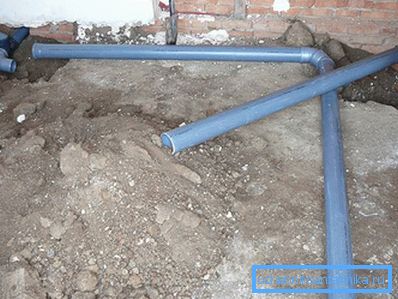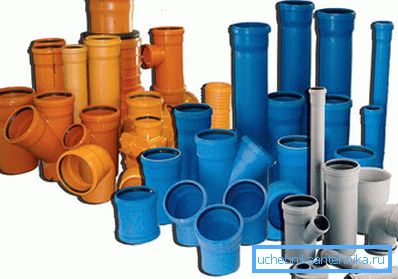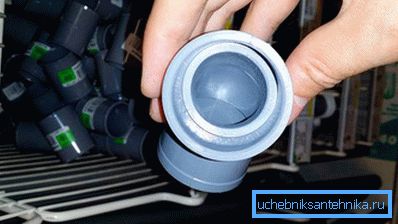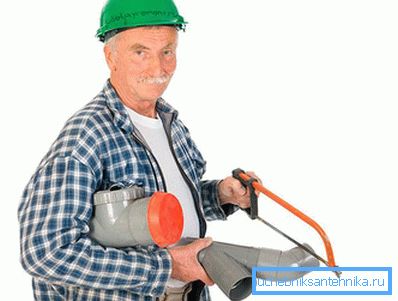Types of sewer fittings
Pipes, which today are quite a lot in construction warehouses and in stores, are manufactured from such polymeric materials as polypropylene, polyethylene, as well as polybutylene and polyvinyl chloride. Pipes from this raw material are resistant to any aggressive substances, they are easy to install, they weigh little and are known for their long service life.
To perform the installation of sewage, it is necessary to use fittings for sewer pipes, which help to assemble the system without welding and threaded connections. What types of sewer fittings exist today?
PVC sewage systems

In the past, sewers were collected from pipes made of cast iron. For these pipes used metal fittings. Now they use PVC pipes and fittings. Thanks to the component parts of this material it is possible to successfully solve many issues that arise during the installation of sewage systems. To date, the use of polymeric materials has made it possible to significantly improve the properties of sewage networks during their operation, making them less expensive than cast iron constructions.
Advantages of polymer fittings

Used in our time, pipes and fittings made from polymers, have many positive differences from other materials.
Ease designs. This moment is almost the most important, because the low weight allows the installation of pipes to just one person, and not to the whole crew, as it was before. In addition, pipes and fittings are much easier to deliver - enough of a small light-duty truck to bring a complete set to a two-story cottage!
Long service life. The service life of PVC fittings is usually at least 30 years, a maximum of 40. Given that this value is just a warranty period, in fact, pipes and polymer polytings can serve for half a century, since they are immune to the effects of corrosion, are not afraid of moisture, temperature extremes, aggressive environments In addition, the joints of pipes and fittings do not overgrow, and corrosion deposits do not appear on them.
Ease mounting. To put together all the parts used in the installation of the sewer system in the house, only manual labor is needed, and it is also simple. In fact, the entire system is assembled like a constructor - the edge of one pipe is simply put on the other end of the next pipe. Similarly, the assembly of pipes and fittings. To perform the installation, you do not need to have special skills - it is enough to master the basic techniques.
Ability to use different options allows you to create sewer systems of any levels of complexity.
Having considered the advantages of PVC products, we turn to the fittings themselves - what they are, what types they are and how to choose the required fitting for installation.
Fittings for plastic pipes

Fitting is the part of the pipeline that is required to connect several pipes at an angle, in the case of joining more than two pipes and so on. Also fittings allow you to connect the local sewage system with the city highway.
Where are the fittings used? Most often they can be found in the installation of sewage in residential buildings, and this can be both residential buildings in the city and beyond, and in high-rise apartments. Can fittings be used in systems where drains with a temperature not exceeding 80 ° C flow through, as well as for diversion of short-term drains? temperature 95 ° C. Under the drains means not only dirty water from the sink, toilet or shower, but also certain chemical compounds, whose coefficient, known as pH, has a range from 2 to 12.
Types of fittings

The type of fittings may be as follows:
- those used in systems arranged inside the house;
- those that are used in systems outside the home.
The method of connecting the fittings is also different and can occur using a rubber gasket in the form of a ring and, in rare cases, by gluing. The sealing ring in the latter case does not apply.
Types of fittings

Among the internal sewage fittings connected by a rubber ring, the following elements are found:
- coupling, which, in turn, is of the following types:
- coupling with stop;
- full bore repair coupling;
- reduction - this part is used in cases where the diameters of the pipe and fitting differ significantly, as well as in those cases when a new network of PVC must be connected to cast iron;
- revision with a cover - used in situations where cleaning measures are planned;
- tee - a detail for connecting three pipes; may have angles of 45, 67, 90 °;
- a crosspiece with two planes, angles: 45 and 90 ° (such a crosspiece is also used for unequal diameters);
- plug;
- cross with one plane, also angles of 45 and 90 °;
- tap (with angles of 30, 45, 90 °);
- compensation pipe.
Fittings, which are used for external sewage, and are also connected using a gasket, have a similar set of products. However, there are some differences. So, in this group of fittings there are such details:
- usual tap - here he already has more angles: 15, 30, 45, 67, 90 °;
- two-pipe tap - has rubber rings on both sides;
- coupling - only one type;
- the tee, besides the usual one, can be three-horn, its angle is always straight;
- single-planked cross also at right angles only;
- non-return valve - it is installed on the sewer pipe that goes horizontally, having a slope of 2 cm per linear meter;
- siphon with two elbows.
Equipping an engineering system, it is necessary to use suitable plastic pipes as well as fittings to them so that you can make the correct slope and bends of the sewage system.
Glue fittings

Fittings, which are joined using a special adhesive for polypropylene, can be used both for internal sewage systems and for sewage systems running outside. Here are some fittings needed in this case:
As in the past case, apply the clutch. Sometimes a tap is necessary - the angles of rotation are 30, 45, 87, 90 °. In the case of a tee, the angles of rotation are 45, 67, 90 °, that is, the same as in the tees of the internal sewage system. Reductions, that is, adapters, and revisions with a cover are applied in a similar way.
Other details - a cross with two cavities (45 and 90 °), plugs for pipes. Still used for glue sticks, which have a smooth end, with an angle of 90 °, are needed for tie-in risers. There are also adhesives for glue, which have a socket, also with a right angle.
Mounting fittings

There are a number of useful tips that will help to perform the installation of fittings qualitatively and correctly:
Cut PVC pipes before docking with fittings should be a hacksaw for metal with a small tooth. Due to this, on the edge of the pipe in the place of cutting there will be no sticking pieces of the layer.
After the pipe is cut off, it is worth treating the sawing site, removing burrs and roughness. This will help to fit the fitting more tightly, and during operation of the system there will be no blockages and leakages at the joints.
You should clean the trimmed PVC elements only after the product becomes dry (that is, remove moisture, if it is present on the pipe or fitting).
If voids have formed in the place where pipes and fittings are connected, they should be treated with glue with a brush. Then the installation, made correctly, will help to save the sewer system in order to use it for many decades.
Video
This video catalog also shows the sewer fittings: